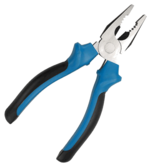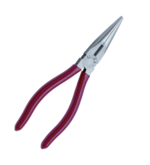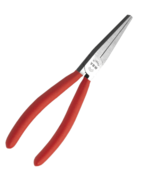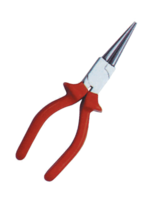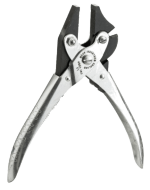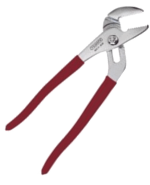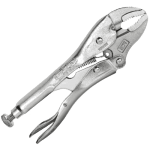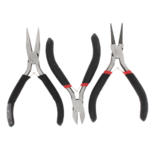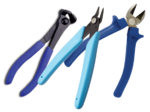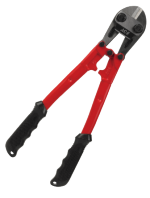Pliers and Cutters: Difference between revisions
From DT Online
(Created Article) |
(Added text and images) |
||
| Line 24: | Line 24: | ||
| [[File:ParallelActionPliers.png|150px|right]] | | [[File:ParallelActionPliers.png|150px|right]] | ||
|- | |- | ||
| [ | | [https://en.wikipedia.org/wiki/Tongue-and-groove_pliers '''Multi-Grip Pliers'''] | ||
| | | When gripping large diameters, the handles of ordinary pliers may be spread too wide to grip comfortably. These overcome the problem by means of a moveable pivot and are often used by [https://en.wikipedia.org/wiki/Plumber '''Plumbers'''] to grip large diameter pipes for example. | ||
| [[File: | | [[File:MultiGrips.png|150px|right]] | ||
|- | |- | ||
| [ | | [https://en.wikipedia.org/wiki/Locking_pliers '''Vice-Grip Pliers'''] | ||
| # | | These can be locked into position, using an [https://en.wikipedia.org/wiki/Bistability#In_mechanical_systems over-center action]. They can also be used as temporary clamps in case a free hand is needed elsewhere ''(e.g. various designs of jaws are available which arew used by [https://en.wikipedia.org/wiki/Welder '''Welders'''] to hold parts in position)'' | ||
| [[File: | | [[File:ViceGrip.png|150px|right]] | ||
|- | |- | ||
| [ | | '''Jewellers' Pliers''' | ||
| Smaller version of '''Snipe Nose''', '''Flat Nose''', and '''Round Nose''' pliers, plus '''End Cutters''', are availabe in sets and used by modellers or Jewellers ''(e.g. when setting stones or creating [https://en.wikipedia.org/wiki/Cloisonn%C3%A9 '''Cloisonné'''] work)'' | |||
| [[File: | | [[File:JewelleryPliersSet.png|150px|right]] | ||
|- | |- | ||
| [ | | [https://en.wikipedia.org/wiki/Diagonal_pliers '''Wire Cutters'''] | ||
| | | Unlike '''[[Scissors]]''' or '''[[Tinsnips]]''' the blades of these come together to cut through the wire rather than sliding past each other in a '''[[Power Shear and Nibbler|shearing action''']]. The blades may be straight and sharpened from both sides ''(like an '''Axe''')''' or, often for lighter and more accurate work, they can be set as '''Diagonal Cutters''' or '''End Cutters''' and sharpened from one side only to produce a neater, flush cut. | ||
| [[File: | | [[File:WireCutters3.png|150px|right]] | ||
|- | |- | ||
| [ | | [https://en.wikipedia.org/wiki/Bolt_cutter '''Bolt Cutters'''] | ||
| | | With long handles, short blades and a '''[[Compound Lever]]''' operation, these are capable of exerting the considerable force required to cut through steel bars and bolts. | ||
| [[File: | | [[File:BoltCutters.png|150px|right]] | ||
|} | |} | ||
[[Category:Tools and Equipment]] | [[Category:Tools and Equipment]] | ||
Revision as of 21:02, 8 October 2015
As with Scissors and Pincers, most Pliers, Wire Cutters and Strippers are based on two Class 1 Levers operating together to provide the gripping action, although a few could be more accurately described as a Compound Lever (e.g. Parallel Action Pliers and Bolt Cutters).
| Combination Pliers | The most commonly used Pliers found in the toolbag of most tradesmen. The jaws are designed to grip both flat and round stock and there is the addition of a wire cutter (in between the jaws) and a wire stripper (on the outside of the jaws either side of the fulcrum). | |
| Snipe Nose Pliers | Also known as Long Nose Pliers or Needle Nose Pliers depending on the size and proportion of their jaws, these are almost as universally used as Combination Pliers but they can reach into more inaccessible areas (at the cost of some loss of grip). | |
| Flat Nose Pliers | These have tapered jaws that are serrated on their flat inner surfaces enabling them to be used to grip and bend small metal parts and to twist together wires | |
| Round Nose Pliers | Most commonly used by Jewellers, Silversmiths and Electricians to create loops in the end of wire. | |
| Parallel Action Pliers | The jaws open and close parallel along their entire length to produce a square vice-like grip. The Compound Lever action operates on a Parallelogram type arrangement to produce a considerable Mechanical Advantage for both cutting and gripping operations. | |
| Multi-Grip Pliers | When gripping large diameters, the handles of ordinary pliers may be spread too wide to grip comfortably. These overcome the problem by means of a moveable pivot and are often used by Plumbers to grip large diameter pipes for example. | |
| Vice-Grip Pliers | These can be locked into position, using an over-center action. They can also be used as temporary clamps in case a free hand is needed elsewhere (e.g. various designs of jaws are available which arew used by Welders to hold parts in position) | |
| Jewellers' Pliers | Smaller version of Snipe Nose, Flat Nose, and Round Nose pliers, plus End Cutters, are availabe in sets and used by modellers or Jewellers (e.g. when setting stones or creating Cloisonné work) | |
| Wire Cutters | Unlike Scissors or Tinsnips the blades of these come together to cut through the wire rather than sliding past each other in a shearing action. The blades may be straight and sharpened from both sides (like an Axe) or, often for lighter and more accurate work, they can be set as Diagonal Cutters or End Cutters and sharpened from one side only to produce a neater, flush cut. | |
| Bolt Cutters | With long handles, short blades and a Compound Lever operation, these are capable of exerting the considerable force required to cut through steel bars and bolts. |
